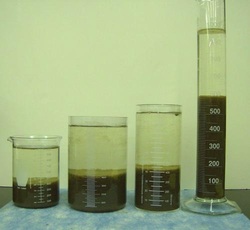 Impact of Cylinders on SV30
Impact of Cylinders on SV30 Procedure
Add 1000 ml of mixed liquor to the cylinder. Start timer an allow the product to settle. You can take readings every 5 minutes, but often we just take a reading after 30 minutes. By tanking readings every 5 minutes, you get a settling curve that provides more information on how the floc performs in secondary clarification. While we normally use the SV30 number, in systems with changing MLSS concentration or comparing different systems, we would do the SVI calculation. SVI > 150 is con
SVI = SV30/ MLSS (in grams)
Interpreting Results
- If the floc settles rapidly but leaves pin floc in solution or fine floc floating on the top, it indicates an "old sludge". In the secondary clarifier this results in undesirable turbidity and TSS passing into the effluent. As a result, you should increase wasting rates.
- If the floc does not compact as much as normal, you may have young sludge, filamentous or non-filamentous bulking. Young sludge will also have a high oxygen uptake rate and many bacteria cells in free-solution outside the floc. In this case, it will take time for the biomass to develop and can indicate increased loadings. If the increased loadings are causing problems with solids carryover in the clarifier, instead of using secondary polymers or restricting flow it could be time to add bioaugmentation products to shorten the time for floc development in the biological treatment unit.
- Filaments and non-filaments are a different situation than young sludge. Each filament and type of bulking is caused by a number of factors. If the microscopic exam shows substantial filaments and or diffuse floc, it is best to look at the biological unit for the causative factor and make changes to promote better floc formation thereby reducing growth pressures for filaments.

 RSS Feed
RSS Feed